Payson to Strawberry
Situated at an elevation of roughly 5000', Payson is Gila County's largest town and is in the northern part of the county. The population here exceeds over 15,000 people and it is a great place to stay at and it has a lot of restaurants, stores, and staying places. In the town of Payson itself there are hiking trails, city parks, and a few nature areas that are of easy access. The dominant habitat surrounding Payson are pinyon-pine and juniper woodland, as well as ponderosa pine and gambel's oak woodland. These situations can make for a productive birding area. There are also places to bird on the immediate outskirts of town in multiple directions. This area will extend north along Highway 87 to the small communities of Pine and Strawberry. The elevation climbs up more when driving north of Payson to these communities and the locations fall right below the Mogollon Rim. In Birding in Gila County, this area will be the first of five areas that have sections of high elevations that can be birded that sit right below the Rim.
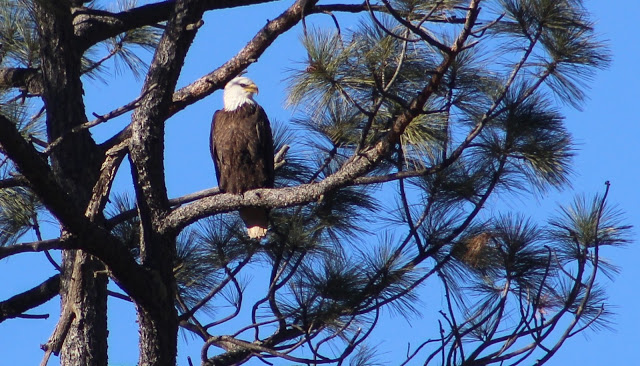
Directions: The base point for directions in this area will be from the center of Payson, at the Highway 87 and Highway 260 intersection.
BIRDING LOCATIONS
Green Valley Park Area
-Green Valley Park: This park is extremely popular for Payson visitors and residents alike and is usually a crowded place throughout the day. It is stopped at and birded fairly often too by birders visiting Payson. The park has a lake and a few small ponds, as well as many trees and plantings throughout the park. Among the 180 species that have been found there, interesting birds that have been discovered have included Surf Scoter, Greater Scaup, Northern Parula, Black-and-white Warbler, and Rufous-backed Robin. From the Highway 87 and Highway 260 intersection in Payson, head south on Highway 87 for 0.7 mile and turn west on Country Club Drive. Take Country Club Drive west for another mile to Green Valley Park, where the parking lot for the park will be on the north side of Country Club Drive. Scope the main lake for waterbirds and walk around the lake to look for various songbird migrants and residents throughout the year. The north side of the park away from the lake can be productive. At the southeast corner of Green Valley Park, cross Country Club drive and bird two ponds on the south side of the park, which are on both sides of Green Valley Parkway as it intersects with Country Club Drive.
-Private Golf Course near Green Valley Park (Payson Country Club): Northwest of Green Valley Park is a private golf course and pond that can be viewed from public road. From Green Valley Park, take Green Valley Parkway immediately north from Country Club Drive at the southeast corner of the park. After driving shortly north, take Lake Drive west for a total of a half mile to where Lake Drive turns into W Rim Drive (by looking at maps). At the half-mile and ending point to public access, there is a pond on the west side of Lake Drive that commonly has waterfowl variety in it. Before the ending limits, solid views of the open golf course are attainable. Canada Geese and other waterfowl are often present on the course and on a pond in the course. Cackling Geese have also been found here before.
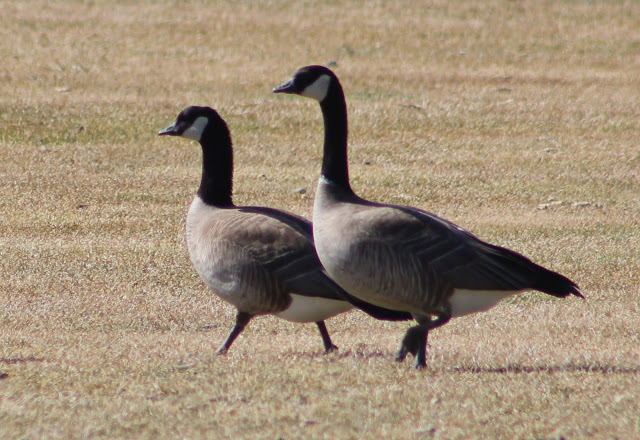
-Payson Public Golf Course: From Green Valley Park, continue west on Country Club Drive for about a half mile. The Payson Public Golf Course welcomes both golfers and visitors on the course. There are two sides to the golf course, and S Vista Road divides the two sides of the course. Once continuing past Vista Road's intersection with Country Club Drive, Country Club Drive becomes W Doll Baby Ranch Road. The westernmost portion of the course is best for birding. It has a few parking pull offs on the north side of the road. There are open lawns, weedy habitat edges, surrounding juniper woodland, and most importantly, a thick cottonwood and willow riparain area that runs through the course that should attract a variety of migrants throughout the year.
-American Gulch: This is an area that has a hiking trail, as well as easier roadside birding along a riparian area with willows and cottonwoods. The riparian habitat is the main draw of birding American Gulch, and it has good potential. Northern Waterthrush and Lawrence's Goldfinch have been found. The surrounding area has chaparral habitat and juniper woodland and the bird species that are typical of that habitat environment. To get to American Gulch, continue west past Green Valley Park on Country Club Drive/Doll Baby Ranch Road for 1.5 miles. There will be a wide pull off on the south side of the road, which is the best place to park. Continue walking to the west for more riparian habitat past the initial stands of trees near the immediate pull off.
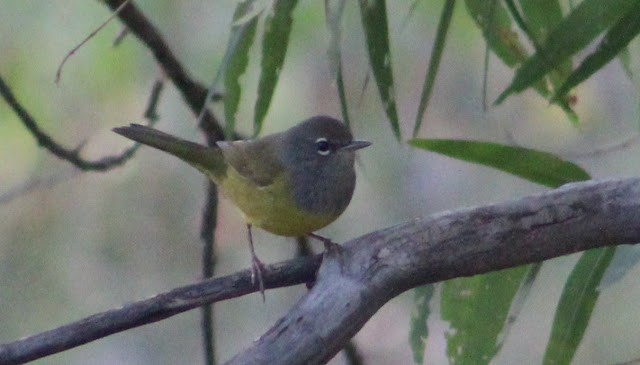
Just North of Payson
-Crackerjack Road (Forest Road 209): Head north of Payson on Highway 87 past the intersection with Highway 260 for 3.5 miles. At 3.5 miles, Crackerjack Road/FR 209 comes into play quickly, and is on the west side of Highway 87. Crackerjack Road is a rough road to drive on, but is a great road to hike on. Along it's route down toward the East Verde River are juniper woodland, chapparral, and ponderosa and oak forest that is worth birding in.
-East Verde River via Flowing Springs Road: To get to this location, head north of Payson on Highway 87 past the intersection with Highway 260 for 4.7 miles. Follow Flowing Springs Road for about a half mile to the campground. Park at the campground or at a pull off further east along the road. From the campground heading east, one can explore the East Verde River just off of Flowing Springs Road for over a mile before private property prevents further access. This is a location with a lot of potential among willow and cottonwood riparain habitat, juniper woodlands, and some nearby pine and oak forest. Birding during migrations are a strong bet for a productive outing.
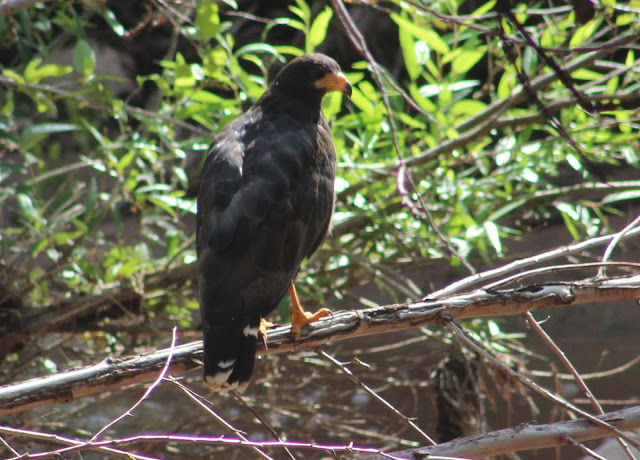
-East Verde River recreation site west of 87 (East Verde Park): This location is similar to the previously described location (Flowing Springs Road), but it is on the west side of Highway 87. A small recreation area is available to bird when pulling in (immediately north after turning in) and by following the road shortly west before it ends at a private community. There are good sections of riparian habitat to explore in this immediate area. Gray Catbird is among the birds that have been found at this site. This site will be on the west side of Highway 87, 5.3 miles north of the Highway 87/Highway 260 intersection in Payson.
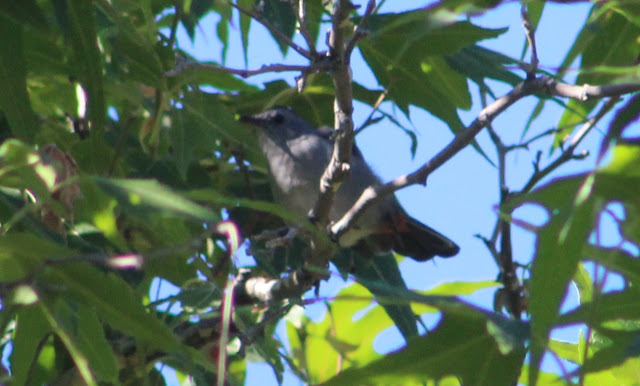
-Boyscout Spring and Sycamore Creek: This area is on the west side of Highway 87 via two stops along the road. The stops come very quickly while traveling north on Highway 87, it's good to be prepared if there's an interest in checking these spots. Sycamore Creek flows into the East Verde River and has an impressive upper riparian habitat. Boyscout Spring also has a similar habitat worth stopping at. The first pull off to this area is 6.2 miles north of the Highway 87/Highway 260 intersection in Payson. Park at the pull off and walk through a gate that prevents further vehicle access. The next pull off is very similar to the previous, and is 6.3 miles north of the 87/260 intersection. Parking at either location can work for birding within the area of both pull offs.
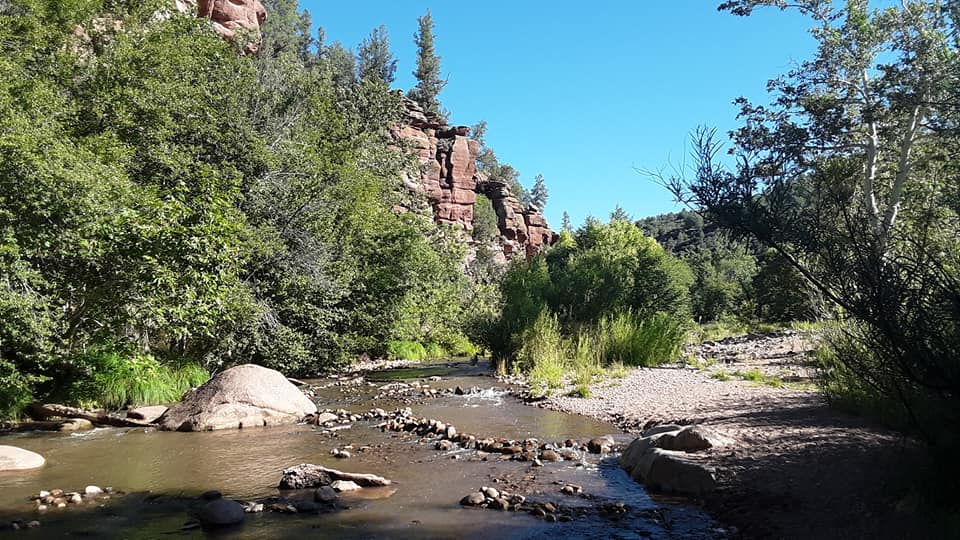
Pine and Strawberry
-Pine Trailhead: At 13.8 miles of driving north on Highway 87 past the Highway 87/Highway 260 intersection in Payson, the Pine Trailhead will be on the right (east) side of the highway. The trailhead parking and picnic area is situated in pine and oak forest, and gives hiking options for several trails. Some of the trails that can be accessed are the popular Highline Trail as well as the Pine Canyon Trail. The Highline Trail (Trail 31) has an impressive length of 51 miles just below and along the Mogollon Rim. The Pine Canyon Trail (Trail 26) travels for 8 miles and ends up above the Mogollon Rim and in Coconino County. Pine Creek Canyon is accessed after 3.5 miles of hiking on this trail, and it is a worthy hike for entering and exploring the canyon. This canyon will be described in more detail below. The trails from this trailhead will host a variety of birds who favor pine, oak, and juniper woodlands, and there will also be plenty of chaparral habitat that will be hiked along. Mixed forests are accessed by take longer hikes, such as the hike to Pine Creek Canyon. Any trail from this location is worth exploring and birding.
-Pine Creek Canyon Drive: At 15.2 miles of driving north on Highway 87 past the Highway 87/Highway 260 intersection in Payson, this road will be on the right (north) side of the highway. This road travels through neighborhoods and private property for a little over a mile, and there are a few places near the end where there is space to park along the road. Pine and oak forest and high levels of deciduous woodland line Pine Creek here in the lower and wider section of Pine Creek Canyon. Walking this road and birding from the road is worth it. Over the last few years, Sulphur-bellied Flycatchers have been found here near where the road prevents further access at the border to the private Camp Lomia (Brian Ison).
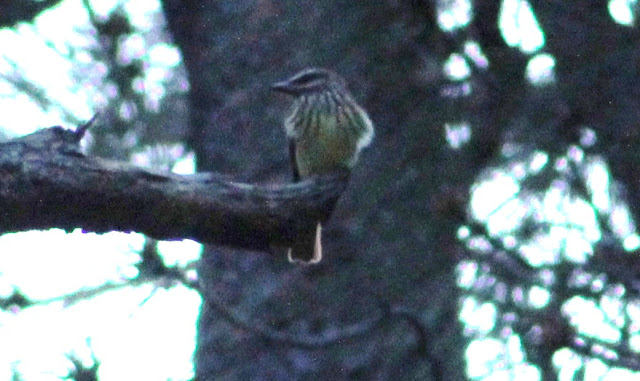
-Upper Pine Creek Canyon: The upper reaches of this canyon start north of Pine Creek Canyon Drive. Because of a private camp, the canyon and the hiking adjacent Pine Creek Trail #26 are accessed from trails that extend from the Pine Trailhead and the Bearfoot Trailhead. It is a lengthy hike to get to this part of Pine Creek Canyon (see directions for Pine Trailhead and Bearfoot Trailhead), but the canyon is worth a hike and is fun to explore. At this point in the canyon's length, the canyon narrows and the habitat composed along the cool running waters of Pine Creek are thick pine and fir forest, oak, and higher elevation riparian trees in line with the creek. As with other locations in Gila County that are similar to this with taking trails along creeks toward the Mogollon Rim (see other areas), birds one will find in spring and summer among a good variety include Downy Woodpecker, Cordilleran Flycatcher, Warbling Vireo, Red-faced, Grace's, and Virginia's Warblers; Western Tanager, and Black-headed Grosbeak. In Pine Creek Canyon, some of the more notable birds that have been found have included Montezuma Quail, Mexican Whip-poor-will, Rivoli's Hummingbird, Broad-winged Hawk, Dusky-capped Flycatcher, Pacific Wren, Gray Catbird, Hooded Warbler, and Northern Parula (all by Brian Ison).
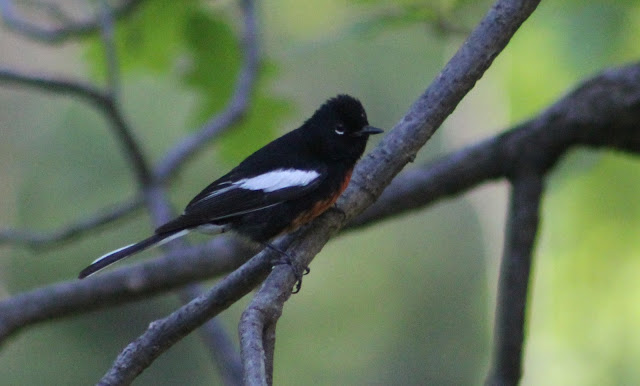
-Bearfoot Trailhead: At 17.1 miles of driving north of Payson on Highway 87 past the direction base point, this will be a side pull off on the right (north) side of the highway. The Bearfoot Trail #13 is a 6.5 mile round trip hike, and it ends at the entrance to Upper Pine Creek Canyon when it intersects with Pine Creek Trail #26. The Bearfoot Trail has great views of the surrounding Pine and Strawberry area and is largely made up of juniper and chaparral habitats before it enters the thicker forest of Pine Creek Canyon.
-Strawberry Canyon: At 18.3 miles of driving north of Payson on Highway 87 past the direction base point, there is an opening on the right (east) side of the highway that accesses a parking area. There is a pull off here on this east side of the highway, but it is not maintained or suitable for parking. Continue north on Highway 87 past Strawberry after noting the point, find a place to turn around, and head back south on Highway 87 toward Strawberry. Just south of the just-mentioned 18.3 mile point on Highway 87, after turning sharply in the southern direction, look on the west (right) side of Highway 87 when heading south for the green "Entering Strawberry" sign. There is a wide enough pull off just before this sign where one can easily park. If attempting to access this location, keep traffic in mind. After parking, walk the short distance to the access point. At the access point, walk through pine, oak, and juniper in the northeast direction along trail in a wider part of Strawberry Canyon. After about 0.3 miles of hiking, take the right fork of the trail and continue to for more of a short distance up the trail until it ends. At this point, the canyon is very narrow, and one can follow a drainage through the canyon further northeast to where it ends barely below the Mogollon Rim. Hiking the drainage is challenging in places. The forest here is composed of thick stands of pine and fir, as well as oak. Sharp-shinned Hawk and Townsend's Solitaire were among the birds detected here as potential breeders.
Back to Gila County Birding Areas |
